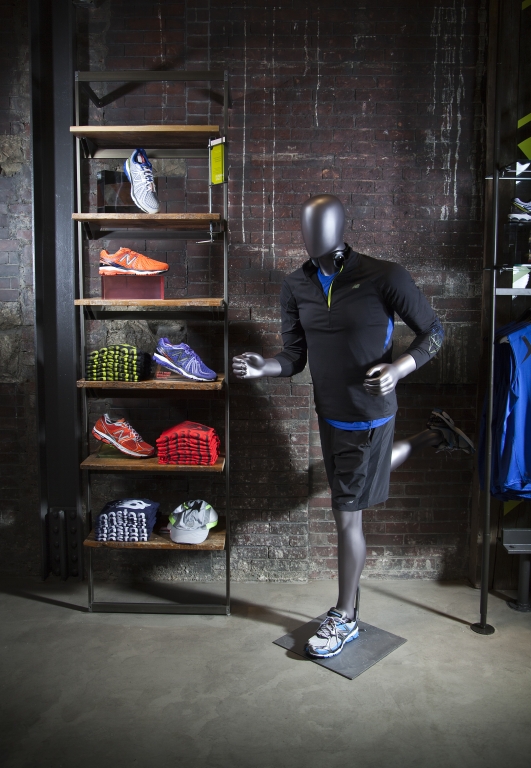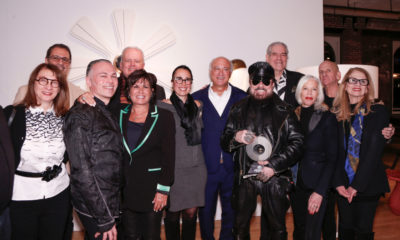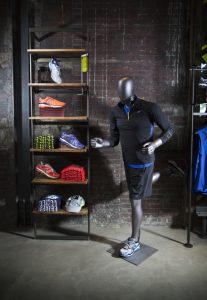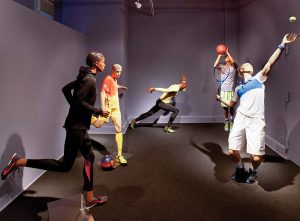Crouched in starting blocks, serving a tennis ball or posed mid-stride, athletic mannequins are moving onto the retail scene, especially among sports apparel outfitters. And while their use raises some typical questions – Hard to dress? Cost efficient? Durable? – visual merchandisers may be implementing them this year as brands muscle for shoppers’ attention.
One example is the New York flagship of Reebok Intl. Ltd. (Canton, Mass.), which saw the addition of athletic forms to display merchandise on Fifth Avenue. The store is attached to a basement-level Reebok/CrossFit box where shoppers can put their merchandise to sweatworthy use.
“I wanted active mannequins that would inspire people to get fit, and showcase our products in ways that they are designed to be used,” says Ryan Clinkscales, Reebok’s senior manager of global retail and head of visual merchandising. He says the mannequins help link the merchandise with its intended use in shoppers’ minds.
Reebok’s design team worked with CrossFit trainers to narrow down forms and poses for a series of CrossFit-inspired figures from CNL Mannequins (Buena Park, Calif.), including a woman lifting dumbbells triumphantly above her head, and a male figure checking his watch while he steps onto a knee-high box.
Peter Mannos, senior manager of retail development for running apparel and footwear brand Brooks (Bothell, Wash.) loves these new forms. He used athletic figures from Greneker (Los Angeles) along with 14 running mannequins (internally dubbed “runnerquins”) for his run-obsessed company’s booth at the Outdoor Retailer show earlier this year. The display helped the company grab a Best of Booth award from show organizers.
When it came time to test a prototype for the booth, Mannos gathered opinions from the avid runners among Brooks’ staffers, particularly asking whether the mannequin’s gait seemed natural: “I didn’t invest in them until I made sure they looked authentic.”
Advertisement
To Bevan Bloemendaal, senior director of global creative services at Timberland (Stratham, N.H.), these aggressive poses are all about visually arresting the shopper’s attention. “We’re all trying to create the notion of kinetic energy … and we need to be disruptive in anything we do right now, specifically in windows and in-store,” he says. “Stopping the shoppers at some level – using all the senses.” For Timberland, Bloemendaal says, that’s accomplished not with mannequins, but with a strategy ensuring merchandise itself grabs attention. There is more than one way, he points out, to be disruptive.
Deb Camarota, creative director, visual merchandising, at Fitch (Columbus, Ohio), has mixed feelings, too. She says she can see realistic, athletic mannequins working for windows or accent pieces, but questions their usefulness for in-store merchandising. “I don’t know that people need to see a technical athletic short on a mannequin in a pose to say, ‘That works for me.’ ”
Camarota says retailers must balance cost and space concerns before embracing this trend. “I just think it takes up more space than is additive to the environment,” she says, “I don’t understand the payoff, especially when it’s typically in front of a fantastic, four-color image.”
Mannos, though considerably more enthusiastic, doesn’t disagree. He advises retailers and visual merchandisers to test these athletic poses first. So does Camarota. “Test them in 10 percent of stores, make the minimum investment and see,” she says.
And Mannos advises retailers to consider the practical, too: “Are your mannequins easy to set up? Easy to change out? If you’ve got a form in the window, you don’t want it there for six weeks with the same outfit on.”
Though Mannos says the running mannequins he selected were a bit more difficult to dress at first, he’s now comfortable with the process. And he agrees that these figures might be better as accent pieces: “If you elevate this piece in a window or at a focal point, people are going to stop and look at it; you can’t help it. If you light it right and have compelling product on it, people aren’t going to just walk by.”
Advertisement
As indoor megaplexes make sports like running, biking, tennis and swimming increasingly seasonless, specialty athletic apparel retailers may be able to use these mannequins all year, Bloemendaal points out.
Still, you don’t have to be a specialty brand like Reebok to harness this trend. Mass merchants like Target Corp. (Minneapolis) are taking cues from active forms, incorporating poses that suggest athletics without being sport-specific. For example, Target recently launched a standalone store for its activewear line, C9 by Champion, next to a San Francisco CityTarget. C9 merchandise encompasses everything from sports bras to running shoes, designed for a broad demographic. Target doesn’t typically use mannequins to merchandise this line, says Lee Henderson, a Target spokesperson, but decided to do so for this new standalone.
“The C9 active apparel store is much more focused than our regular stores on bringing the product off the shelf to the guests so they can compare and feel the different performance features,” he says. To that end, mannequins from CNL are posed in a way that suggests they’re on their way to the gym, rather than about to strut down a runway.
For retailers hoping for a few seconds of pause from potential shoppers, whether they be everyday athletes, gym rats or fitness fanatics, these active poses command attention and just might be worth a test.


 Photo Gallery6 days ago
Photo Gallery6 days ago
 Headlines2 weeks ago
Headlines2 weeks ago
 Headlines6 days ago
Headlines6 days ago
 Headlines1 week ago
Headlines1 week ago
 Headlines2 weeks ago
Headlines2 weeks ago
 Headlines7 days ago
Headlines7 days ago
 Designer Dozen2 weeks ago
Designer Dozen2 weeks ago
 Special Reports2 weeks ago
Special Reports2 weeks ago


















